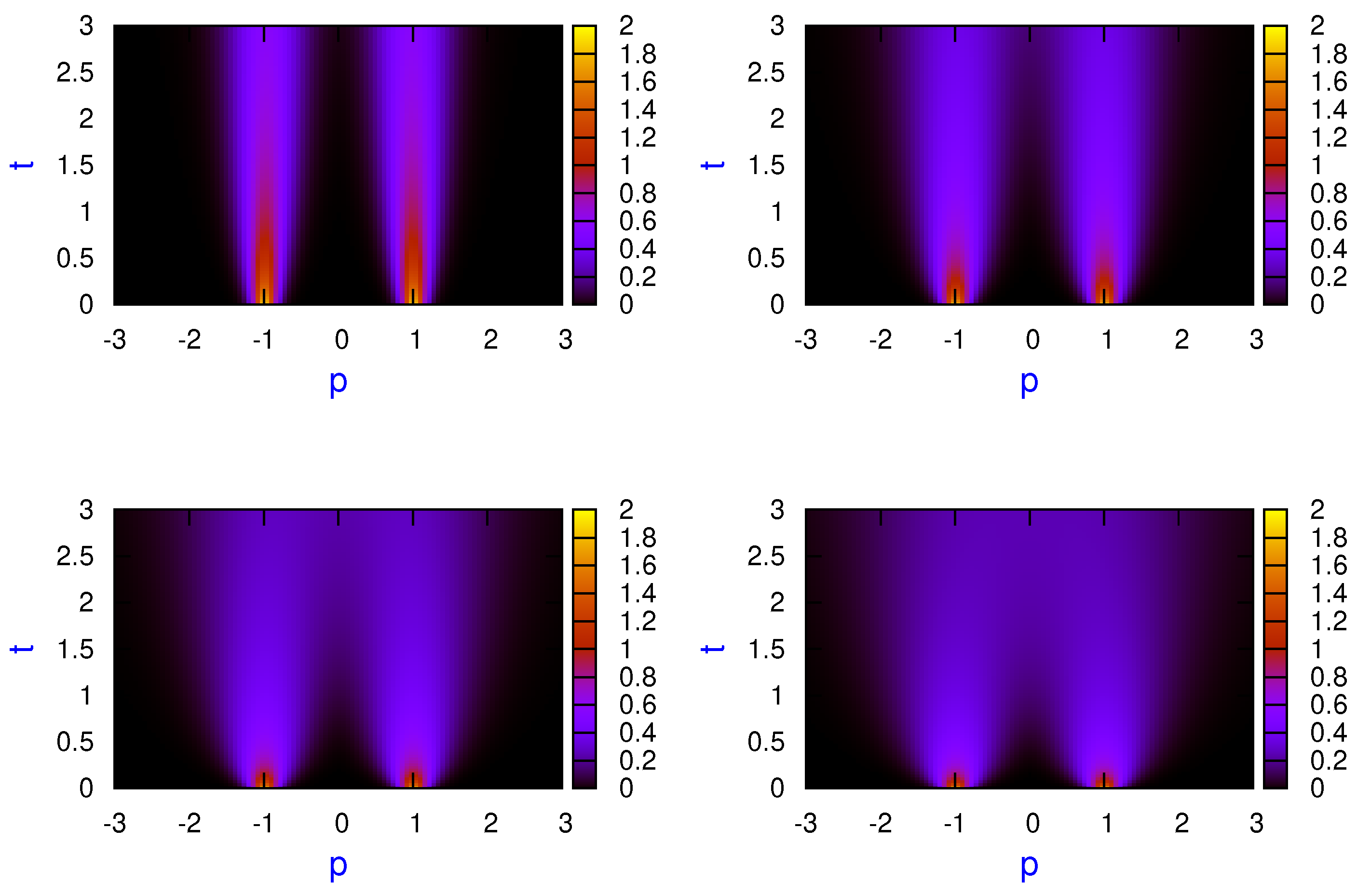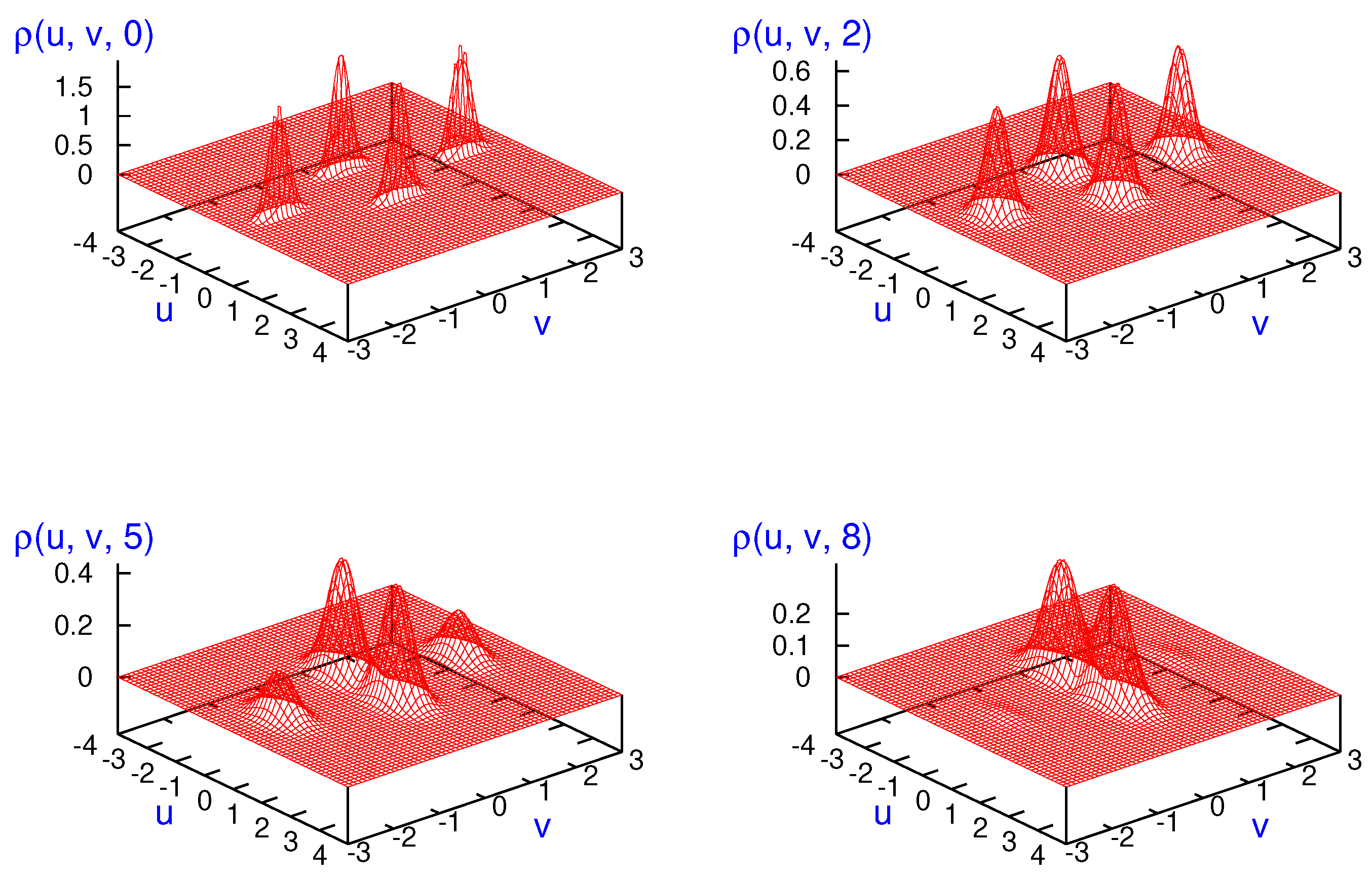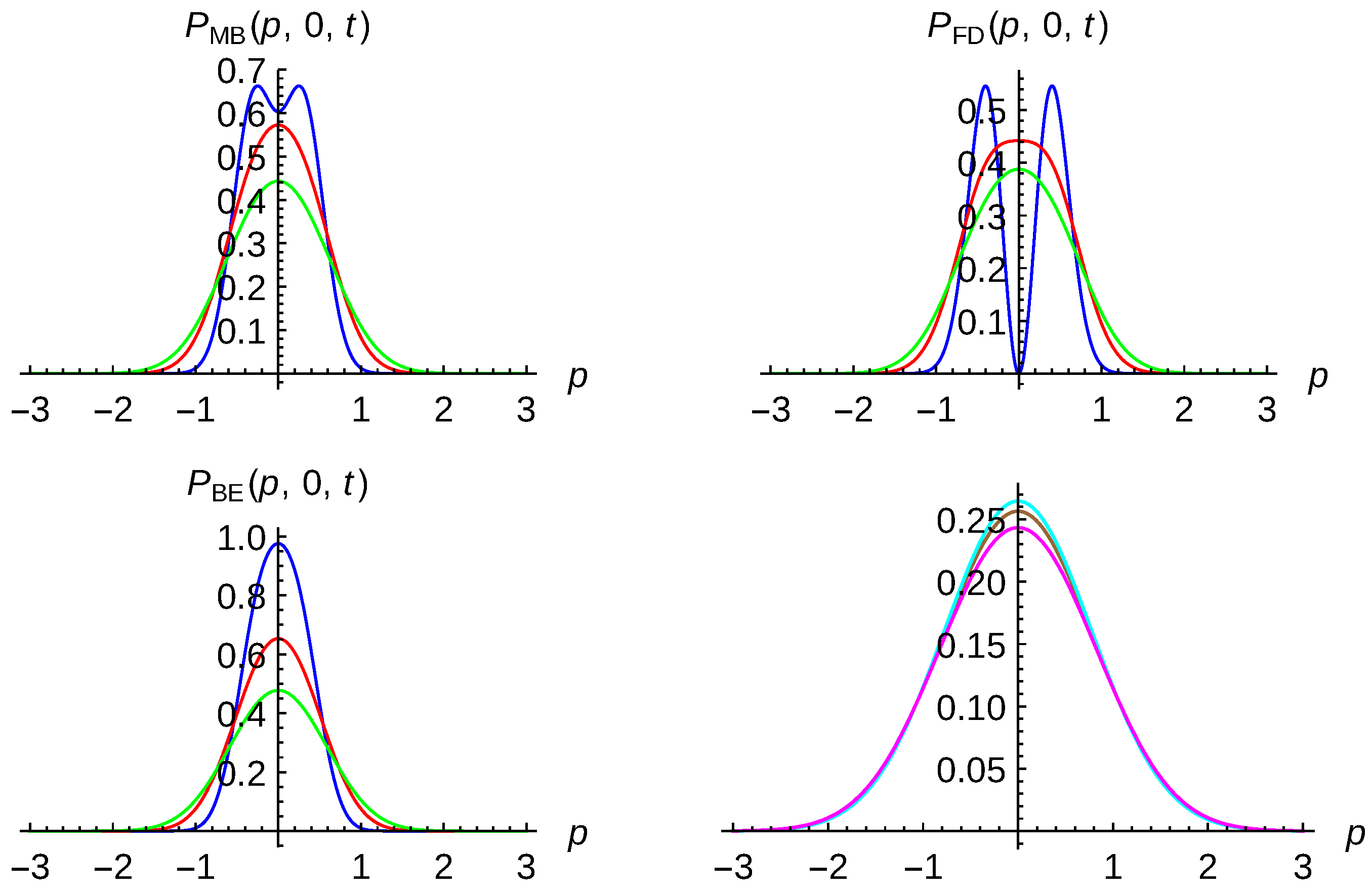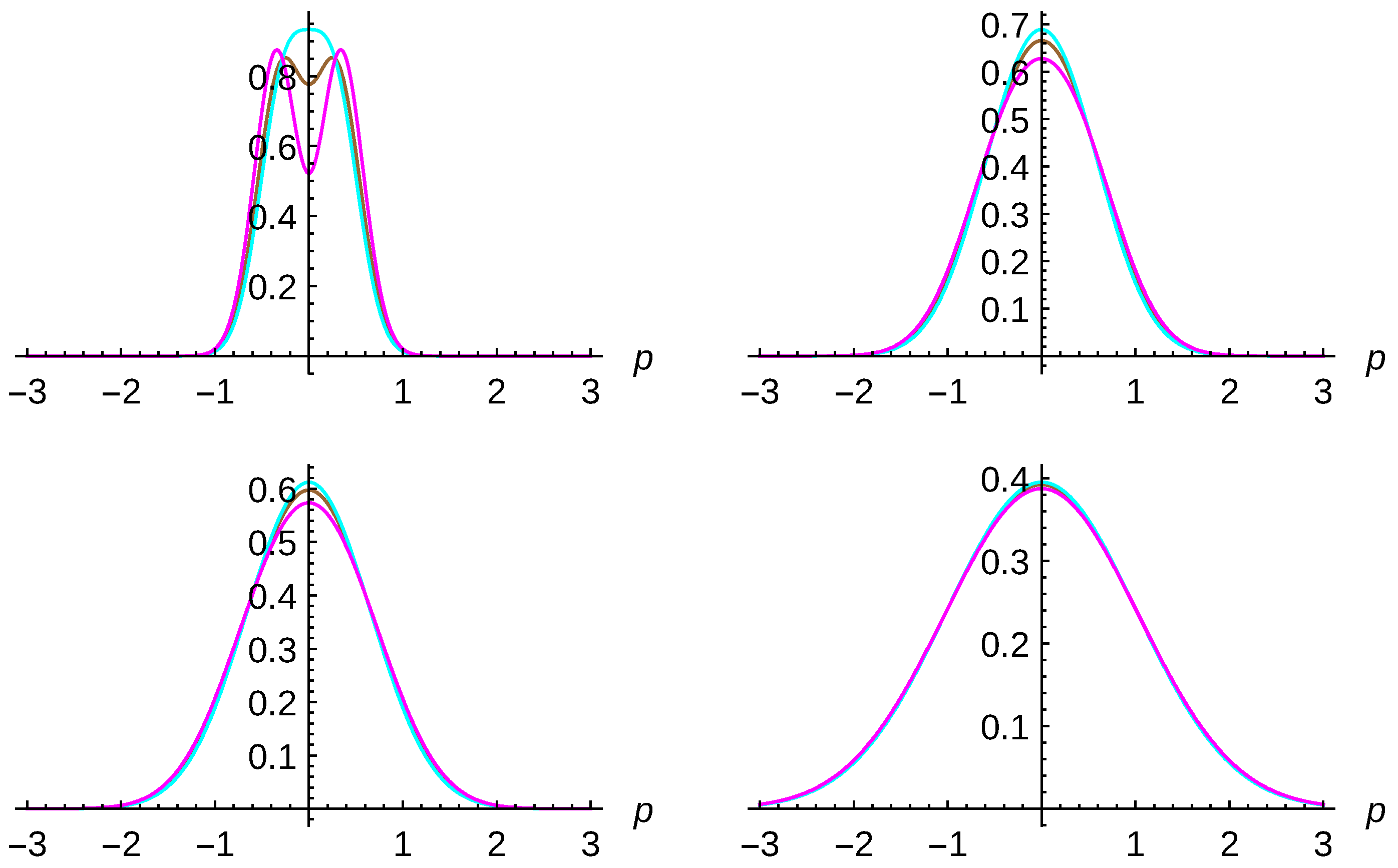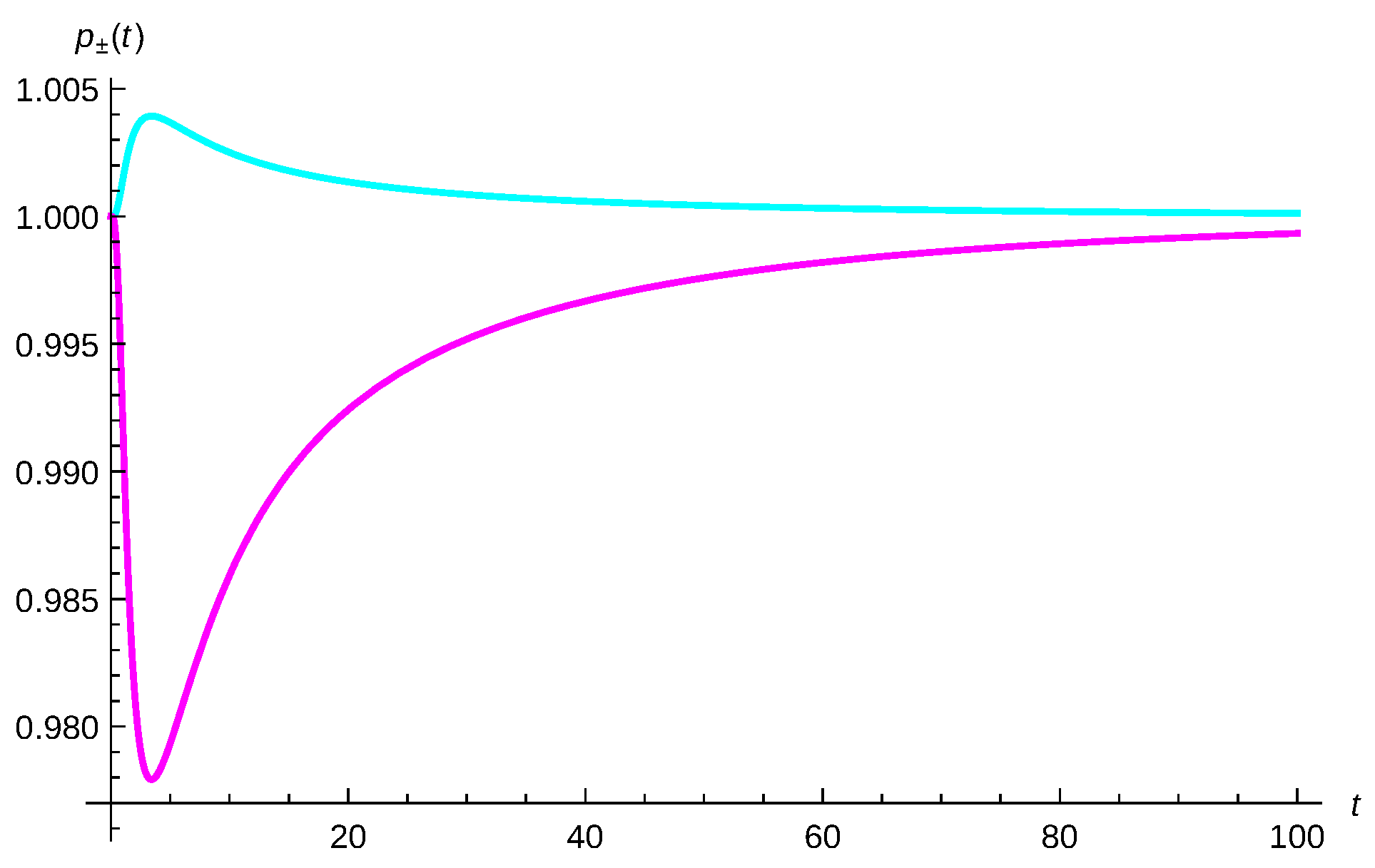1. Introduction
Decoherence is a crucial process in order to better understand the emergence of classical behavior in the quantum dynamics of physical systems [
1,
2,
3,
4]. This process arises when the physical system of interest interacts with an apparatus to carry out a measurement or when it is immersed in a given environment. The theory of open quantum systems is the natural framework to carry out these kinds of studies and has been widely developed from quite different approaches and published in several books [
5,
6,
7,
8,
9,
10,
11,
12]. Within the theoretical methods working with wave functions instead of reduced density matrix, one can find some approaches within the so-called Caldirola–Kanai and Scrödinger–Langevin frameworks [
13,
14,
15,
16]. Both approaches are not following the system-plus-environment model but effective time dependent Hamiltonians and nonlinear Schrödinger equations, respectively. Recently, interference and diffraction of identical spinless particles in one slit problems [
17] have been analyzed.
In this work, we are going to focus on the so-called Caldeira–Leggett (CL) formalism [
11,
18]. This formalism is based on the reduced density matrix once one carries out the integration over the environmental degrees of freedom. As is well-known, the diagonal matrix elements give probabilities and off-diagonal matrix elements are called coherences. In the decoherence process, these off-diagonal elements go to zero more or less rapidly depending on the parameters characterizing the environment—usually, damping constant and temperature. Most of the studies involving quantum decoherence are being carried out in the configuration space and very few in the momentum space. Venugopalan [
19] studied the decoherence of a
free single minimum-uncertainty-product Gaussian wavepacket in the CL formalism within the context of measurement processes both in position and momentum spaces. This study revealed that the emergent
preferred basis selected by the environment is the momentum basis. By considering a cat state, decoherence
without dissipation has been studied in phase space [
20]. To this end, these authors considered the quantum system in thermal equilibrium and assumed a weak interaction with the environment in a way that dissipation could be neglected. Then, from principles of statistical mechanics, the corresponding probability distribution were obtained by averaging over a thermal distribution of velocities. Furthermore, the Wigner phase space distribution function was also obtained and the destruction of the interference term was studied as a function of time. Decoherence was claimed not to occur in momentum and phase space. More recently, decoherence in momentum space has been studied in the context of suppression of quantum-mechanical reflection [
21] using a master equation resembling the CL equation [
11,
18] in the negligible dissipation limit; and for a non-relativistic charged particle described by a wave packet under the presence of linear interaction with the electromagnetic field in equilibrium at a certain temperature [
22]. Recently, in the chemical physics community, studies about purity are also found questioning this quantity as a measure of decoherence in the dynamics of quantum dissipative systems [
23,
24,
25].
The central goal of this work is to show how decoherence affects the open dynamics of cat states and identical spinless (bosons and fermions) particles within the momentum representation, far less investigated than in the configuration space [
26]. For cat states, while the stretching parameter speeds up the decoherence, the external linear potential strength does not affect the decoherence time; only the interference pattern is shifted. Furthermore, the interference pattern is not observed for minimum-uncertainty-product-Gaussian wave packets in the momentum space. Purity, a quantity appeared in the definition of the
linear entropy, and its relation to coherence length is studied taking into account the role of the stretching parameter. The next question is how the symmetry of the corresponding wave functions is manifested in the decoherence process. This process is understood here as the loss of the indistinguishable character of those particles due to the gradual emergence of classical statistics with time. In particular, the well-known bunching and anti-bunching properties of bosons and fermions, respectively, when minimum and non-minimum-uncertainty-product Gaussian wavepackets are used is considered as a function of the environmental parameters, temperature, and damping constant. We have observed that the symmetry of the initial distribution is not preserved in the time evolution of the corresponding wave functions. However, fermionic distributions are slightly broader than the distinguishable ones and these are similar to the corresponding bosonic distributions. This could be interpreted as a residual reminder of the bunching and anti-bunching character of the initial distributions in the momentum space but washing them out when increasing the damping constant and temperature. This general behavior has also been confirmed by carrying out a different theoretical analysis from the single-particle probability. Finally, an indirect manifestation of these properties for bosons and fermions have also been observed when considering the so-called simultaneous detection probability.
This paper is organized as follows: in
Section 2, the CL master equation in the momentum representation is briefly introduced. In
Section 3, open dynamics and decoherence of minimum and non-minimum-uncertainty-product Gaussian wavepackets are analyzed for cat states and under the presence of a linear potential. Then, open dynamics of two identical spinless particles (bosons and fermions) are analyzed in
Section 4. In
Section 5, results, discussion, and some concluding remarks are presented.
4. Decoherence for Two-Identical-Particle Systems
Equation (
1) is linear in
. Writing it as
,
being a linear operator and assuming
and
are two one-particle states describing two non-interacting particles 1 and 2, one can easily see that the time evolution for the product state
is given by
Let us consider now a system of two identical
spinless particles. According to the spin-statistics theorem, the state of such a system must have a given symmetry under the exchange of particles; (anti-)symmetric for identical (fermions) bosons. By taking the initial momentum-space wavefunction as the pure state
and
being one-particle wave functions and
the normalization constant for bosons (+) and fermions (−), then the time evolution under the two-particle CL Equation (
45) yields
where
Although
and
are one-particle densities,
and
are not. However, all of these functions are solutions of one-particle CL Equation (
3) satisfying the continuity Equation (
7). The joint detection probabilities are given by the diagonal elements of Equation (
47);
where
and the last term of Equation (
49) is due to the symmetry of particles. In this context, and due to the environment, this term becomes zero over time, and we have decoherence in the sense of indistinguishability loss. Note that, for distinguishable particles obeying the Maxwell–Boltzmann (MB) statistics, the probability density is given by
For the single-particle density,
, one obtains
where the overlapping integral
is
Due to the continuity Equation (
7),
is a constant which does not depend on the environment parameters
and
T and time:
. On the other hand, if the system is isolated, states evolve under the Schrödinger equation and we have
A comparison of Equations (
52) and (
54) reveals that, for open systems, the quantity
plays the role of
. Thus, in analogy to Equation (
31), we have again
leading to
By considering now one-particle states
and
as
minimum-uncertainty-product Gaussian wave packets i.e., as in Equation (
10)
, with parameters
,
,
and
,
,
, respectively, one obtains
where
Note that, for
, one has
.
and
are given by Equation (
13) by using appropriate momenta. For
from Equation (
56), one obtains
One sees that the decoherence function is negative and the same for both bosons and fermions. The decoherence process due to the last term of Equation (
52) is interpreted here as loss of being indistinguishable as described in [
17]. Notice that the case
can take place only for bosons for which then the wave function (
46) takes the product form just as classical states, revealing that quantum statistics is unimportant when the decoherence function
becomes zero. Another possibility for vanishing the last term of Equation (
52) is when the overlapping integral is negligible. In such a case, the quantum statistics is unimportant too. However, this possibility can also happen in isolated systems, and it is not a result of interaction with the environment. Therefore, one should consider the effect of environment on
and
as an additional source of decoherence taking place for identical particle systems.
Decoherence can also be studied through what is called simultaneous detection probability i.e., measuring the joint detection probability for both particles in a given interval of the
p-space. If we consider a detector, in momentum space, located at the origin with a width
, then the
ratio of simultaneous detection probability of indistinguishable particles to the distinguishable ones is given by
where ± corresponds to bosons (Bose–Einstein statistics) and fermions (Fermi–Dirac statistics), respectively.
5. Results and Discussion
Numerical calculations are carried out in a system of units where
. In
Figure 3, probability densities (
31) together with Equations (40a) and (40b) are plotted for the cat state of two minimum-uncertainty-Gaussian wave packets,
, for
and different values of temperature:
(left top panel),
(right top panel),
(left bottom panel) and
(right bottom panel). The initial parameters used are the same as in
Figure 2. As discussed previously, no interference pattern is observed in the momentum space at any temperature. Obviously, the width of the probability density also increases with time.
In order to gain some insight on this open dynamics, information about the reduced denrity matrix in the
-plane is helpful. Thus, in
Figure 4, density plots in the
-plane at different times are shown for the cat state consisting of two minimum-uncertainty-product Gaussian wavepackets in the absence of external potential. The off-diagonal matrix elements
are shown at
(left top panel),
(right top panel),
(left bottom panel) and
(right bottom panel) for
,
,
and
. It is clearly seen how the coherences or off-diagonal matrix elements goes to zero at long times. The same behavior is observed when the stretching parameter is different from zero as well as the linear potential is present, this decoherence process being a little bit faster.
Decoherence for identical particle systems discussed in previous section can be analyzed in several ways. First, in
Figure 5, two-particle probability density plots for finding a particle with zero momentum and the second one at any value are shown. These results are issued from Equation (
51) for two distinguishable particles obeying the MB statistics (left top panel) and Equation (
49) for two identical bosons (left bottom panel) and fermions (right top panel) at different times:
(blue curves),
(red curves) and
(green curves). The right bottom panel depicts the same two-particle probability density for distinguishable particles (brown curve), identical bosons (cyan curve) and identical fermions (magenta curve) at
. One-particle states are taken as minimum-uncertainty-Gaussian wave packets with the same width
and opposite kick momenta
and
. The parameters of the environment have been chosen to be
and
. As can be seen, for distinguishable particles obeying the MB statistics, the two lobes at
describes the two initial separated Gaussian wave packets. With time, the corresponding Gaussian wavepackets broaden and the two lobes disappear; the maximum being also around to zero momentum for the second particle. For bosons and fermions, the dynamics are quite different. The normalization factor also plays an important role since, from (
59), one has that
where
. According to Equation (
59), for our parameters,
and
. The blue curves in each case display different behavior. At the initial time, bosons display a bunching-like behavior and fermions a clear anti-bunching like behavior, compared to distinguishable particles. For this open dynamics, the last term of Equation (
49) together with the overlapping integral
governs clearly the time evolution. The decoherence process takes place at
which is at least one order of magnitude less than the relaxation time
. It should be emphasized that the decoherence time depends strongly on the choice of the one-particle states parameters. For instance, for motionless Gaussian wave packets with different widths
and
where
and
, the decoherence process takes place close to the relaxation time. With time, the initial bunching and anti-bunching character of the initial distributions are not preserved. Finally, in the right bottom panel, the two-particle probability density for the three kind of particles is plotted at
. As expected, the time behavior for the three types of particles is quite similar by starting from quite different initial conditions. Notice, however, that the fermionic distribution is a little bit broader than the distinguishable, and this is similar to the bosonic one. This can be seen as a reminder of the bunching and anti-bunching character of the initial distributions.
The second analysis one can carry out is on the single-particle probability. We can ask ourselves which is the corresponding probability density for finding a particle with momentum
p independent on the momentum value of the second particle, see Equation (
52). This is shown in
Figure 6 for distinguishable particles (brown curves), identical bosons (cyan curves) and fermions (magenta curves) at different times
(left top panel),
(right top panel),
(left bottom panel) and
(right bottom panel). One-particle states are taken as minimum-uncertainty-Gaussian wavepackets with the same widths
but opposite momenta
and
. Environment parameters have been chosen to be
and
. For these parameters, the decoherence time is one order of magnitude less than the relaxation time. The same behavior is observed with respect to the previous figure.
The third type of analysis is by considering the simultaneous detection probability given by Equation (
64). In
Figure 7, the relative simultaneous detection probability
(cyan) for two identical bosons and
(magenta) for two identical fermions, measured by a detector with a width
located at the origin are plotted. One-particle states are taken to be minimum-uncertainty-Gaussian wavepackets with the same widths
but opposite momenta,
and
, and the damping constant has been chosen to be
. Using Equations (
49) and (
51) in (
64) yields
In this figure, we can clearly see that, at short times, the symmetry of the corresponding wave functions is patent but at asymptotic times the simultaneous detection probability tends to one; that is, to the classical or MB statistics for both bosons and fermions.
Finally, in this work, we have put forward evidence of the quite different behavior of the decoherence process in the momentum space when considering cat states and identical spinless particles—whereas, with the first states, no diffraction pattern is observed in this space when compared with the configuration space for minimum uncertainty product Gaussian wave packets, a residual manifestation of the well-known bunching and anti-bunching properties of bosons and fermions is observed with time. This behavior is washed out more rapidly when increasing the damping constant and temperature.


